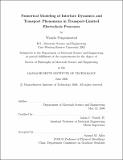| dc.contributor.advisor | Adam C. Powell, IV. | en_US |
| dc.contributor.author | Pongsaksawad, Wanida | en_US |
| dc.contributor.other | Massachusetts Institute of Technology. Dept. of Materials Science and Engineering. | en_US |
| dc.date.accessioned | 2007-04-03T14:08:25Z | |
| dc.date.available | 2007-04-03T14:08:25Z | |
| dc.date.copyright | 2006 | en_US |
| dc.date.issued | 2006 | en_US |
| dc.identifier.uri | http://dspace.mit.edu/handle/1721.1/36209 | en_US |
| dc.identifier.uri | http://hdl.handle.net/1721.1/36209 | |
| dc.description | Thesis (Ph. D.)--Massachusetts Institute of Technology, Dept. of Materials Science and Engineering, 2006. | en_US |
| dc.description | This electronic version was submitted by the student author. The certified thesis is available in the Institute Archives and Special Collections. | en_US |
| dc.description | Includes bibliographical references (p. 111-117). | en_US |
| dc.description.abstract | Electrochemical reactions in materials and processes induce morphological instability on the cathode, which can lead to porous deposits or system failure. The growth of the protrusion is a complex phenomenon which involves chemical, electrical, and momentum driving forces in the system. Thus, it is important to understand the effect of electrochemistry in phase boundary evolution in order to optimize the performance of such processes. This thesis contributes to predicting and controlling such interface instability phenomena by developing a computational model that captures them. Successful application of the model to emerging metal extraction processes demonstrates its usefulness. A phase field model of electrochemical interface is developed for transport-limited electrolysis with rapid charge redistribution. This new Cahn-Hillard phase field formulation includes a model electrostatic free energy term, which captures the behavior of the diffuse interface under the applied electric field, in addition to transport by free energy gradient and convection. The model agrees with published stability criterion for a solid cathode. When the electrodes and electrolyte are low-viscosity fluids, flow stabilizes the interface. | en_US |
| dc.description.abstract | (cont.) A new stability criterion for metal reduction in a liquid-liquid system is derived and agrees well with the model results. Next, the phase field model is extended for a ternary system to model titanium reduction in a supported electrolyte system. The model can simulate phase boundaries migration depending on the composition of the electrolyte and also electronically mediated reactions. Finally, Solid Oxide Membrane Electrolytic Smelting with Rotating Cathode (SOMERC), an emerging technology to electrolytically reduce titanium oxide from molten salt, is investigated. In the SOMERC process, rotational flow is introduced to create shear force that is expected to stabilize the interface. Computational fluid dynamics models of rotational flow are carried out to estimate the relationship between cathode rotational speed, shear strain rate, and boundary layer thicknesses. The phase field model presented in this thesis can be applied to any electrochemical reduction processes that are in the mass-transport controlled regime. Stability criteria and detailed morphology in two and three dimensions can be explored. | en_US |
| dc.description.statementofresponsibility | by Wanida Pongsaksawad. | en_US |
| dc.format.extent | 117 p. | en_US |
| dc.language.iso | eng | en_US |
| dc.publisher | Massachusetts Institute of Technology | en_US |
| dc.rights | M.I.T. theses are protected by copyright. They may be viewed from this source for any purpose, but reproduction or distribution in any format is prohibited without written permission. See provided URL for inquiries about permission. | en_US |
| dc.rights.uri | http://dspace.mit.edu/handle/1721.1/36209 | en_US |
| dc.rights.uri | http://dspace.mit.edu/handle/1721.1/7582 | |
| dc.subject | Materials Science and Engineering. | en_US |
| dc.title | Numerical modeling of interface dynamics and transport phenomena in transport-limited electrolysis processes | en_US |
| dc.type | Thesis | en_US |
| dc.description.degree | Ph.D. | en_US |
| dc.contributor.department | Massachusetts Institute of Technology. Department of Materials Science and Engineering | |
| dc.identifier.oclc | 76905477 | en_US |
